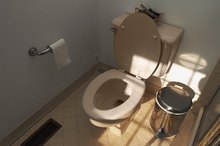Kidney Stone Infection Symptoms
When a kidney stone blocks the tubes that drain urine from the kidneys to the bladder, called the ureters, urine collects in the kidneys, causing a kidney infection. Kidney stones may block the tube that drains the bladder, called the urethra, and cause cystitis or inflammation and irritation of the bladder. Infection ensues. Infection in the urinary system causes distinct symptoms and, if not treated quickly, can cause serious illness and kidney damage.
If you are experiencing serious medical symptoms, seek emergency treatment immediately.
Fever
A person with an acute kidney stone may have a low grade fever, less than 100.6 degrees Fahrenheit, according to Donna D. Ignatavicius, MS RN, and M. Linda Workman, Ph.D., authors of “Medical-Surgical Nursing: Critical Thinking for Collaborative Care.” But a higher and persistent fever indicates infection and should be evaluated by a physician 1.
Nausea and Vomiting
Signs of MRSA & Urinary Tract Infection
Learn More
A history of a kidney stones along with nausea and vomiting indicates a kidney infection or pyelonephritis. Pyelonephritis makes the individual feel very ill, sometimes requiring hospitalization. People with pyelonephritis may not even be able to tolerate clear liquids.
Cloudy Urine
A kidney stone that partially or completely blocks the urethra prevents urination. Urine concentrates in the bladder and causes infection. Once a person can void, the urine will be dark amber, malodorous and cloudy, and may cause a burning sensation during urination.
Frequency
Signs of MRSA & Urinary Tract Infection
Learn More
Scott and White Healthcare explains that an infection in the bladder causes frequency, or the urge to urinate often. A kidney stone in the bladder irritates the lining of the bladder, causing swelling and pain. Frequency is often accompanied by painful urination. People may try not to void because of the pain, further compounding the problem.
- Scott and White Healthcare explains that an infection in the bladder causes frequency, or the urge to urinate often.
- A kidney stone in the bladder irritates the lining of the bladder, causing swelling and pain.
Abdominal Pain
A person feels abdominal pain as a kidney stone travels through the ureter and urethra. Characterized as colicky, a stone in the ureter will cause pain on the side of the abdomen where the stone is located. However, diffuse lower abdominal pain and tenderness to abdominal palpation indicates cystitis, and a person with these symptoms needs medical evaluation.
Flank Pain
Kidney stones cause flank pain when lodged in the kidney or ureter, according to the National Kidney Foundation 2. Once the stone travels to the bladder flank, pain should resolve. A person who complains of increasing flank pain could have pyelonephritis, especially if this symptom is accompanied by fever, nausea and vomiting.
Related Articles
References
- “Medical-Surgical Nursing: Critical Thinking for Collaborative Care”; Donna D. Ignatavicius MS RN, & M. Linda Workman Ph.D.; 2006
- National Kidney Foundation: Kidney Stones
- National Institute of Diabetes and Digestive and Kidney Diseases. Symptoms & Causes of Kidney Stones. Updated May 2017.
- National Institute of Diabetes and Digestive and Kidney Diseases. Definition & Facts for Kidney Stones. Updated May 2017.
- Brikowski TH, Lotan Y, Pearle MS. Climate-related increase in the prevalence of urolithiasis in the United States. Proc Natl Acad Sci U S A. 2008;105(28):9841–9846. doi:10.1073/pnas.0709652105
- National Institute of Diabetes and Digestive and Kidney Diseases. Treatment for Kidney Stones. Updated May 2017.
- National Kidney Foundation. 6 Easy Ways to Prevent Kidney Stones.
Writer Bio
Patricia Nevins is a registered nurse with nearly 20 years of nursing experience. She obtained her Master of Science in nursing with a focus in education from the University of Phoenix. Nevins shares her passion for healthy living through her roles as educator, nursing consultant and writer.







